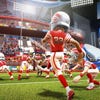Kinect Sports: Season 2
Shake a leg.
The aim and swing work much as you'd imagine, but the game does a great job of gauging the power of your shot. Without an on-screen gauge, this has always been something of a dark art, yet Season 2 makes it seem easy. It helps that you have unlimited practice swings that let you see exactly where the ball will land, but it's still surprising how often shots play out exactly as you wanted. It's especially impressive given that Kinect is reading your body movements sideways, rather than the front-on view it was created to expect, and the developers are clearly pleased with this new addition to their Kinect toolbox.
Golf has more than just solid swing mechanics though. There are lots of clever little touches that make it one of the most distinctive events in the game. Key to this is how Kinect has been woven into the golf experience in a way that feels invisible. Lift your hand to your forehead in the classic "lookout" pose and the game gives you a flyover of the fairway. On the green, crouching down lets you inspect the contours of the ground while a simple "cold, warm, hot" shot indicator makes lining up a putt a simple pleasure. If you need to change clubs, you simply say "Change club" and then call out the one you want.
It all adds up to a small but almost perfectly formed golf game. Indeed, with a few more courses (a nine-hole match is the maximum at the moment), it could almost stand alone as a separate product.
American Football fills the "how will that work?" slot taken by Proper Football in the first Kinect Sports. It's a complex sport, and it's understandably been boiled down to the most exciting parts, offering the chance to play as quarterback and receiver.
There are six plays in all; two short range, two medium and two long. You choose your play (again, via voice control or gesture menu) or get the AI coach to pick the best one for your situation, and then call to your teammates to toss the ball back to you. Pick the receiver in the best position, and throw them the ball when their indicator turns green, showing that they're in a position to catch.
Then it's time for some cardio as you sprint for the endzone. The faster you run, the more tackles you'll dodge, although this element feels a little random. An early feature, seen at E3, where you could physically dodge your opponents has been removed for simplicity, but it can leave the offensive play feeling a little unfair. It doesn't always feel like you could do anything to stop the opposing team getting a down.
What American Football does offer is strategy, even with the limitations of six plays. Picking the right one makes a noticeable difference to your chances, and played co-operatively with one player as quarterback throwing to the other player as receiver, it offers more depth than the basic throw-and-run movements suggest.
And then there's Darts, a curious companion to the other sports, but one that helps to round out a commendably varied selection. It's also yet another example of just how good Rare is at this motion control lark. Accuracy has been improved from within centimetres in the first game to mere millimetres this time around, and that becomes clear once you find the rhythm of the darts event.
As in every other darts game, you first guide a floating crosshair over the board. Pulling back your hand locks your view, but the skill then comes in the throw itself. Shots can still go wide, but by throwing as if you were holding a real dart - the slow drawback followed by a short, sharp throw - it's possible to start hitting treble twenties in your first game. In fact, the accuracy is so impressive that it feels very weird - almost as if there's an invisible dart flying from your hand and into the screen. Darts is a pastime that has been attempted in games going all the way back to the 1980s, but this is the first one I've played that felt almost exactly like the real thing and rewarded real-world skills accordingly.
And that, more than anything, is where Kinect Sports: Season 2 seems most promising. Each event, quite simply, works as you'd expect it to without your brain having to enter "video game mode". This is a much more eclectic line-up of events, each with its own unique feel; that so many of them feel "right" the moment you step in front of the sensor is quite an achievement, the sort of invisible design work that is easily taken for granted.
It remains to be seen how this roster of sports will maintain its appeal in the long term, but on this evidence it seems that far from being a quick cash-in, Season 2 could well push the boundaries of Kinect harder than any other game this year.















.png?width=291&height=164&fit=crop&quality=80&format=jpg&auto=webp)



